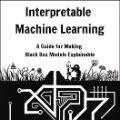Crops are constantly challenged by different environmental conditions. Seed treatment by nanomaterials is a cost-effective and environmentally-friendly solution for environmental stress mitigation in crop plants. Here, 56 seed nanopriming treatments are used to alleviate environmental stresses in maize. Seven selected nanopriming treatments significantly increase the stress resistance index (SRI) by 13.9% and 12.6% under salinity stress and combined heat-drought stress, respectively. Metabolomics data reveals that ZnO nanopriming treatment, with the highest SRI value, mainly regulates the pathways of amino acid metabolism, secondary metabolite synthesis, carbohydrate metabolism, and translation. Understanding the mechanism of seed nanopriming is still difficult due to the variety of nanomaterials and the complexity of interactions between nanomaterials and plants. Using the nanopriming data, we present an interpretable structure-activity relationship (ISAR) approach based on interpretable machine learning for predicting and understanding its stress mitigation effects. The post hoc and model-based interpretation approaches of machine learning are combined to provide complementary benefits and give researchers or policymakers more illuminating or trustworthy results. The concentration, size, and zeta potential of nanoparticles are identified as dominant factors for correlating root dry weight under salinity stress, and their effects and interactions are explained. Additionally, a web-based interactive tool is developed for offering prediction-level interpretation and gathering more details about specific nanopriming treatments. This work offers a promising framework for accelerating the agricultural applications of nanomaterials and may profoundly contribute to nanosafety assessment.
翻译:作物不断面临不同的环境条件挑战。种子的纳米材料处理是一种环保且具有成本效益的解决方案,可用于缓解作物植物的环境压力。本研究使用了56种纳米处理方法,以缓解玉米种子的环境压力。结果表明,7种选择的纳米处理方法显著增加了玉米在盐碱胁迫和干旱热胁迫下的胁迫抗性指数(SRI),分别增加了13.9%和12.6%。代谢组学数据显示,具有最高SRI值的ZnO纳米处理主要调节氨基酸代谢、次生代谢物合成、糖代谢和翻译路径。由于纳米材料的种类繁多且与植物之间的互动复杂,因此了解纳米材料种子处理的机理仍然很困难。使用纳米处理数据,我们提出了一种基于可解释机器学习的可解释结构活性关系(ISAR)方法,用于预测和理解其缓解压力的效果。机器学习的事后和基于模型的解释方法结合起来,提供互补的优势,为研究人员或决策者提供更明确或可靠的结果。确定了纳米颗粒的浓度、大小和Zeta电位是相关盐碱应变下根干重的主导因素,且其效果和相互作用得到了解释。此外,开发了一种基于网络的交互式工具,可提供预测级别的解释,并收集有关特定纳米处理的更多详细信息。该研究为加速纳米材料的农业应用提供了有前途的框架,并可能在纳观安全评估方面做出深刻的贡献。


